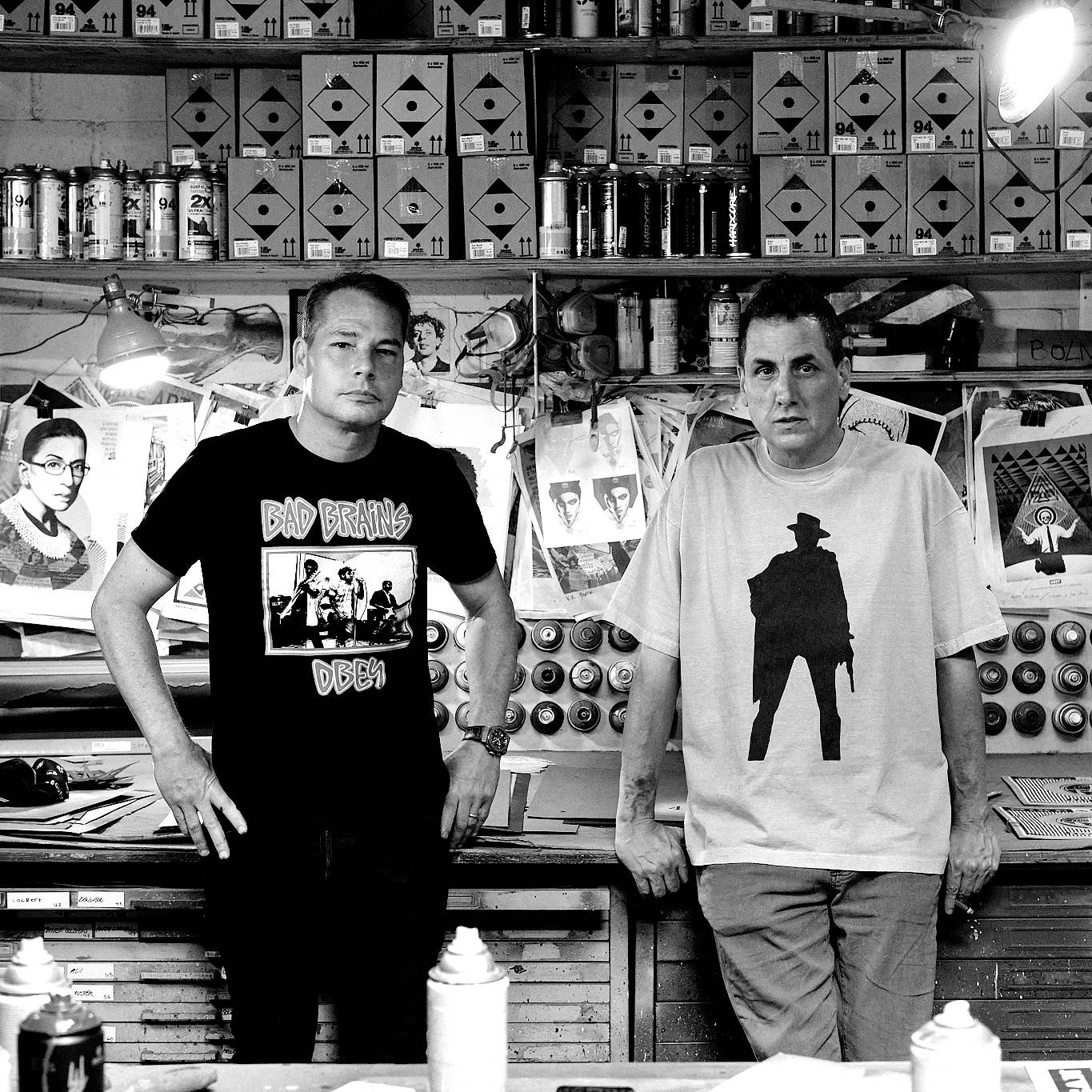
A historic pop culture collab took place last night at midnight when street artist turned cultural provocateur Shepard Fairey joined forces with the legendary hip-hop producer and keyboard wizard Mike Dean for a “Cryptosonic” collaboration called OBEY 4:22. Last night at midnight three limited edition NFTs were made available for just 15 minutes. 48 copies of the first edition, an animated piece by Shep with music by Mike, sold for $1000 apiece. The originals will be auctioned some time next month.
“My music for ‘Cryptosonic’ is a blend of hard-edge trap drums, and an old-school vocoder smashed against prog-rock style synths and guitars,” Dean stated of the track attached to the NFT, which was taken from his brand new instrumental album 4:22. “The gnarly sounds are electrifying and transport us to a higher plane.”
Mike Dean spent his youthful days in Texas racing motorcycles and studying classical piano, while listening to Black Sabbath in his spare time and turning his parents’ garage into a museum of rare synthesizers. He went on to work with everyone from Selena and the Geto Boys to Scarface, Tupac, Jay-Z, Kanye West, and Travis Scott.
“My art for Mike Dean’s ‘Cryptosonic’ is inspired by Mike’s music and the visual stylings of classic 12” square vinyl LP jackets,” Fairey stated. “The composition showcases radio wave transmission, a high-decibel sound system, stereo hi-fi technology, the Earth’s colors of blue and green, and the green herbs many enjoy to enhance a mind-expanding musical journey.”
Young Shepard Fairey rebelled from South Carolina society with a steady dose of skateboarding, punk rock, and hip-hop, progressing from his legendary OBEY sticker and wheatpaste campaign to the iconic HOPE poster for candidate Barack Obama to gallery exhibitions and public commissions designed to stimulate and elevate the public’s social conscious.
OBEY 4:22 is both artists’ first foray into the sizzling-hot NFT space. Forward-thinking musical artists from Curren$y to Grimes to Deadmau5 have all made some serious coin with their early forays into this new creative arena that leverages the power of digital technology to allow artists of all mediums reach their fans directly (and profit handsomely) through the same blockchain-based system that powers cryptocurrencies like Bitcoin.
NFTs have been around since late 2017 when the popular CryptoKitties game first allowed Ethereum users to collect and “breed” non-fungible felines. “Fungible” is a fancy word for interchangeable, so NFTs are a way of making endlessly reproducible digital creations verifiably unique with a provenance as solid as the trusty blockchain. Earlier this month, the beloved 8-bit Poptart pussy Nyan Cat was sold as an NFT for $600,000. But the real wakeup call came in March when Instagram artist Beeple shocked the art world when his Non Fungible Token “Everydays – the First 5,000 Days” was auctioned at Christie’s for $69.3 million, placing a creator of digital memes in the stratosphere occupied by the likes of Jeff Koons and David Hockney, two of the most sought-after artists alive.
Of course, the critical backlash was swift—Beeple’s art was (as his IG calls it) crap. So far, more accomplished artists have yet to plunge into the digital fray, which is what makes last night’s collab so exciting.
One day before the 15-minute bidding frenzy of OBEY 4:22 kicked off, Mike and Shepard tapped in via Zoom for a conversation about crypto-creativity, cannabis, and much more.
What’s up, Shepard?
Shepard Fairey: I’m fine. Been busy. I’m a little stressed. But hey, thanks for having me.
Stressed in what way? Is everything cool?
Shepard: Just that, as things are starting to get more normal, it’s gotten super busy. And I like to stay busy anyway, but there was a healthy rhythm to the COVID creative life that, I have to say, was really good for my blood pressure.
It looks like Mike has just joined the Zoom chat. I see you’re putting one in the air right now! What’s going on Mike?
Mike Dean: Getting ready, it’s 4:21.
Yeah. But you don’t need an excuse to smoke, did you?
Mike: No, I need to wake up.
I was very excited to see you two collaborating on OBEY 4:22. How did this whole collab come about? Who hit up who?
Shepard: My friend Larry Warsh is a big art collector. He works with Ai Weiwei and he’s done a lot of stuff with the Keith Haring estate, and has a big Haring and Basquiat collection. He’s collected some of my work, too. He and Mike know each other, and he connected us. I’m a huge music fan. Love hip-hop. So I knew Mike’s work starting back with the Geto Boys. He’s worked with everybody from Kanye, Travis Scott, Tupac. But when we talked and he said, “I want to do a follow-up album to what I did for 4:20 last year,” which was sort of taking quarantine and coming up with a creative project, which was awesome. I love the music, and I love the idea of us collaborating on something for the sequel.
So this is the first time you’ve ever collaborated. What was the creative process like? What sort of common ground did you discover?
Shepard: We knew of each other’s work, but we’d never actually worked on a project together. The music is done from scratch, the art is done from scratch, but I think Mike knew the palette of sounds he wanted to use. And Mike shared with me some of my art that he liked, so I knew the zone for the collaboration.
Mike: Yeah, exactly.
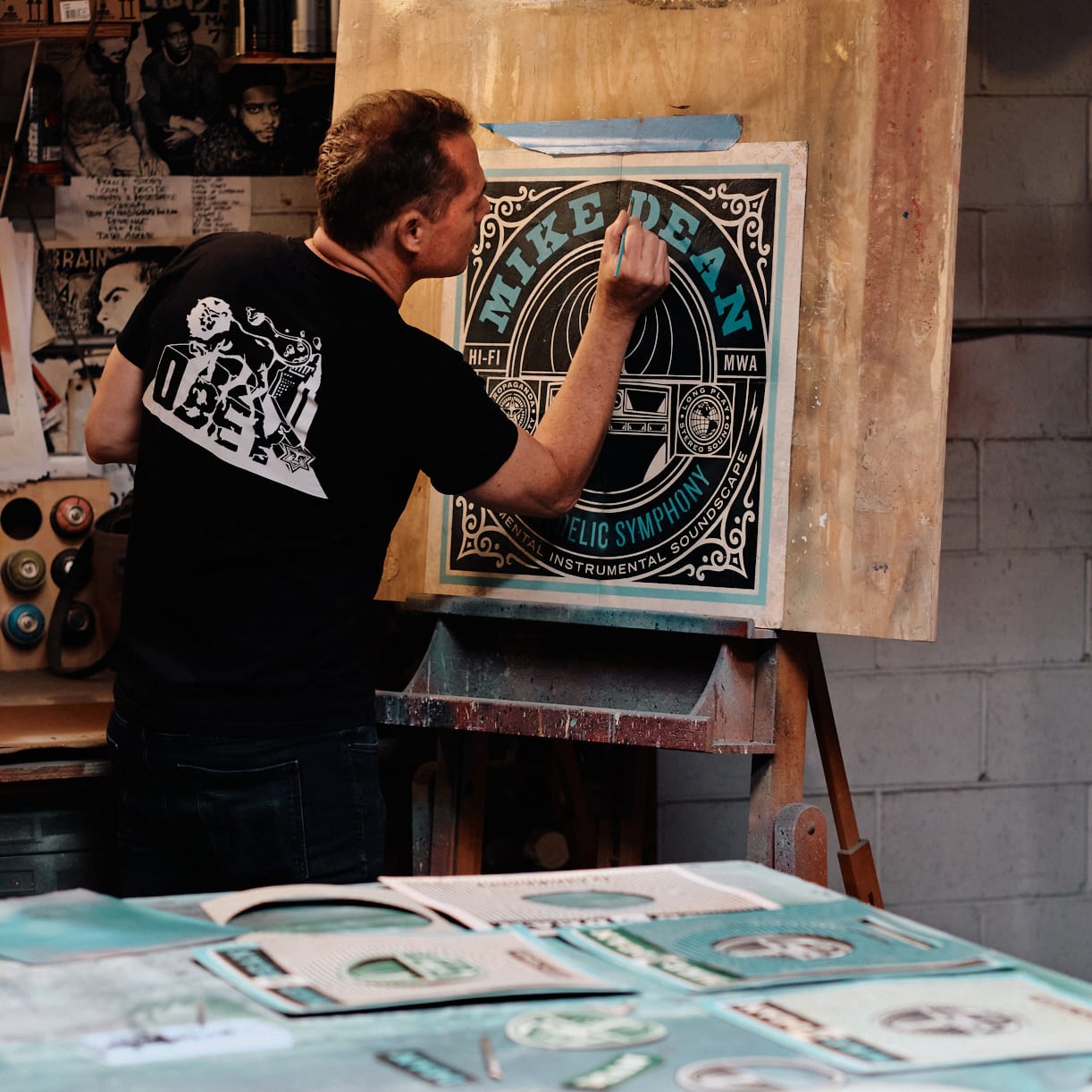
Mike, what was your response to the idea of connecting with Shepherd for this NFT?
Mike: The best news of the year for me. I wanted to do an NFT, but I wanted to make sure I was paired with the perfect artist, and Shepard was the perfect connection. Shout out to Larry’s organization, No More Rulers.
Everybody is buzzing about NFTs right now. I’ve seen a lot of news coverage about it, but I haven’t seen what I consider a really accomplished visual artist getting into the field yet. It’s been more of a novelty thing for the most part, more focused on the technology and the business side of it… Shepard, what was your thought process coming into this NFT space?
Shepard: Well, my thought process is that it’s a natural extension of the way I’m already working in terms of trying to be very accessible and use a lot of different platforms for my work. And because I am such a music fan—and I also love video and motion graphics—the ability to combine art, music, and motion in one thing, without having it be a super expensive production with massive overhead and a lot of different things to deal with… We did put a lot of energy into it and we have a great video piece coming out, too, but in terms of the sort of self-publishing DIY bottom-up power to the people model, this made perfect sense to me.
The way in which music in the MP3 post-Napster era has become something that people don’t value is exactly the same way, other than maybe buying merch or going to a concert and having some tangible interaction with it. An NFT that combines all these things—that’s collectible and trackable on the blockchain—it’s a way for somebody to really show how passionate they are about not just the song that Mike made for this, but Mike’s entire career, and the connection to that. Then, if they feel a connection to my work, then cool.
And it’s got this additional dimension where Mike has a certain aesthetic with some of the motion graphics stuff he’s done, and then I’ve got my thing. And we brought the two together. So, I think you see all of our distinct styles. I love collaborating with the right person. It’s been easy to collaborate with Mike. That’s sort of my take on it. Mike, from a musician standpoint, what attracted you to this space?
Mike: Just that NFT is an uncharted territory. There’s not too many rules, there’s not too many things you have to follow. You can just kind of experiment and try new things. I wanted to start doing like Easter egg things in NFTs—cool stuff that people can find. We’ll probably figure out some more cool stuff for the auction and later in May.
So what’s the plan for the visuals that I’ve seen?
Shepard: These first three are a timed open edition, a 15-minute release, for Thursday night. And then in addition to that, there’s more music and more NFT imagery which will come with the motion component as well as experiences with Mike—having a smoke-in at the studio and giving the individual stems to the tracks that allow… I mean, I’m assuming when I’ve gotten stems from people, that’s pretty much like a license to do your own remix. I don’t know whether you’re looking at it that way, Mike, but…
Mike: Yeah.
Shepard: And then I made physical art of the top two tiers for those winners that have a physical thing. It’s separate from the NFT, but it’s basically like an unlockable physical piece that, if they resell the NFT, they still get to keep the physical art.
I work with analog illustration and analog art, and then I use digital tools. I see all these things as having so much value in how they cross over. And so, to me, this is a way of having that part of my philosophy be in this project. And I think Mike feels the same way. I mean, he’s using electronic tools and analog synths and all sorts of things. You’re in both worlds as well, Mike, so…
Mike: Yeah. One of the main things that I think is great for visual artists like yourself is the royalty on resale of the NFT in the aftermarket, which is unique to NFTs. You guys have been getting screwed over for years. [Laughs.]
Shepard: Yeah, that’s true. But I mean, the residuals for streams or radio play for musicians are really small, too. So, especially for smaller musicians who might have a devout following, they’re never going to have the volume of plays that end up meaning that they can live from that. The NFT itself, both in the initial sale and later sales, can help to supplement their income in a meaningful way. So I think that’s really valuable. And Mike and I both believe in charity. So with this, I think we’re both gonna donate a portion of the money to people who have been faced with the draconian sentencing for marijuana dealing or possession that’s really disproportionate to how marijuana is viewed. It’s criminal justice reform, basically, that ties into Mike’s 420 connection. We’re just looking at ways that this can satisfy all the stuff we’re interested in. And I think a lot of other musicians and visual artists will be empowered to do similar things, because there isn’t a lot of bureaucracy to have to go through. If you’re working with a label or a gallery, they might not want to be associated with the sort of social commentary side of weed politics or whatever.
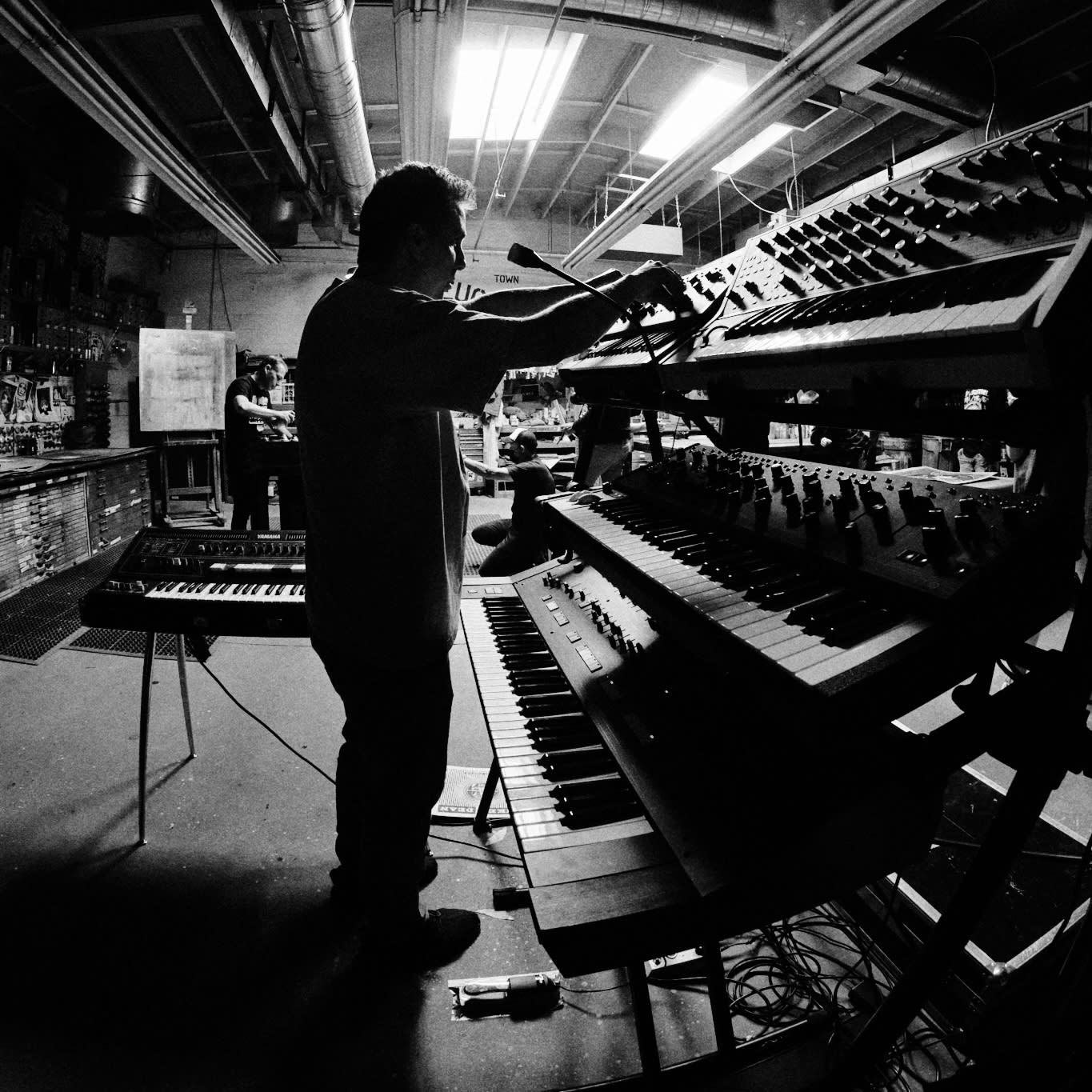
Well, this is a great way of cutting out the middleman and just directly connecting to your audience. Mike, can you tell me a little bit about the music on this album, 4:22? What was your vision for the whole project?
Mike: Over half the album was made on my Twitch livestreams… Where I just turn on the cameras, stream audio out to the fans and just come off the top of my head and freestyle, you know? The same way I made the 4:20 album. It’s kind of fun like that. You kinda just turn on the synths. You call your palette of synths for the night and you just put the sounds in and go. It’s fun.
I see you’re surrounded by keyboards as we speak right now. Do you have a tried-and-true favorite keyboard that you reach for when all else fails?
Mike: I mean, my Moog Voyager is… you know. But now, the Yamaha CS-80 that I just purchased is my new base camp, I call it.
I’ve read interviews where you talked about how important it is for you to use original sounds in all of the work that you do. You’re not as much of a sample-based producer. But you’ve had your music sampled on many other projects, right?
Mike: Yeah, that’s cool actually.
What was your favorite sample that you’ve heard done of your work?
Mike: Probably Ashanti, “Baby.”
Yeah. The Scarface, right?
Mike: The Scarface “Mary Jane” songs, she sampled that. That was a nice surprise. It was a good song.
It was nice creatively and I hope also financially for you, because that was a big hit.
Mike: Yeah, it was cool.[Laughs.]
I read that early in your career you were actually one of the first musicians to work with Selena, and I’m curious at that time, were you also playing keywords for her?
Mike: Yeah, if you look at the old clips from the TV shows, you could see me on a Roland Juno and a Moog—the same shit I use now. That was my first job out of high school. I was 18 and I had the choice to either take off and play with Parliament Funkadelic, because Bernie Worrell was leaving, or to play with Selena. And I just got married and Selena offered more money, so I went with Selena.
Wow, that’s a legendary decision. I understand that you were also really into motorcycles at an early stage of your life. Is that true?
Mike: Yeah. I used to race. I was sponsored by team Suzuki through my teenage years, back when motocross was just starting. All the cool shit.
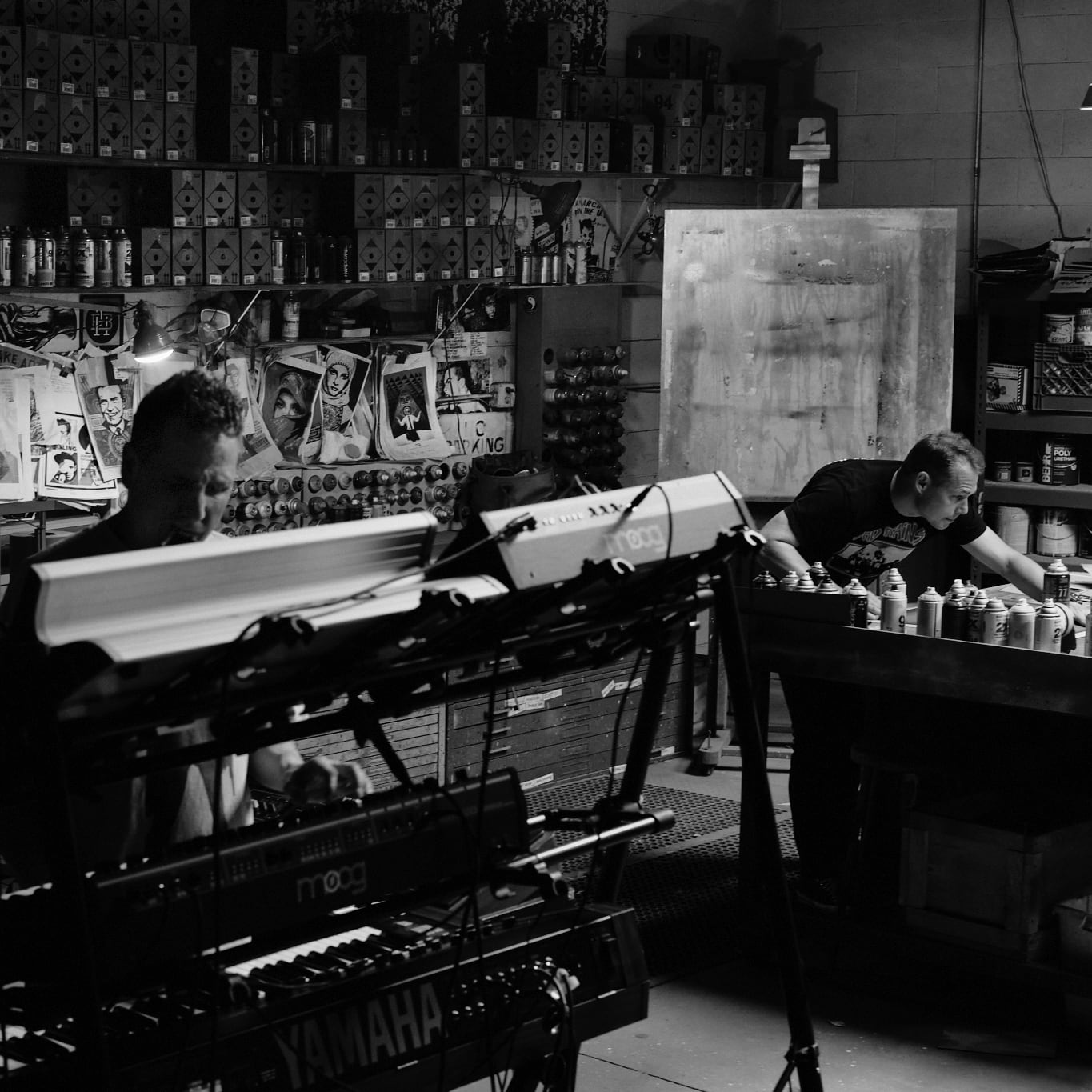
That’s incredible. Shepard, if I’m to believe what I read on the internet, you were heavy into skateboarding in an earlier part of your life?
Shepard: Oh, yeah. Skateboarding and punk rock changed my life. And then, a short time later, hip-hop came with that, too. Beastie Boys, Run-DMC, Public Enemy, Eric B. & Rakim, Boogie Down Productions. That was the new punk rock. So, all of these creative, visceral, rebellious things were just… It just suited my needs. I grew up in South Carolina, and breaking out of the prep school scene was what I needed to do, and those were the vehicles. I skateboarded on Sunday, actually. My friend’s got a mini ramp at his house. But I don’t skate that much anymore. The way that skateboarding is rebellious and creative and sort of looking at ways to use the landscape differently—obviously that mentality translated to street art really easily. You know, looking at the architecture, whether it’s a handrail or a fire escape… It’s sort of ingrained in me now.
And they’re both illegal to some extent, right? A lot of times the cops will chase you off of public steps and stuff like that.
Shepard: Yeah. My first police abuse of authority graphic—of which there have been many, many since—was a cop grabbing a kid holding a skateboard. And it just said, “Prevent police boredom, skateboard.”
Mike, when was the first time you ran afoul of the law? What was your first run in with the police?
Mike: I mean… Smoking pot. [Laughs]
That’ll do it.
Mike: I grew up in a shit town, you know, Angleton, Texas. And the police, as always, seemed to find me when I had weed.
Is marijuana legal in Texas yet?
Mike: No. You can still go to jail for a seed in Texas.
For a seed? That’s crazy.
Mike: Texas is insane.
You seem to be quite at home in California where the laws have changed a lot.
Mike: Yeah. It’s great out here.
Is it ever weird to you, though? I know I’ve spoken to people who feel like they almost miss the days before the corporate people got into the weed industry.
Mike: I mean, you still get better weed direct than you can in the stores.
Right, right. Back to this idea of cutting out the middleman. Plug in right to the source.
Mike: Hopefully we can get a pound NFT soon! [Laughs.]
I haven’t seen that done yet, but that’s probably some brilliant inspiration in that concept, bringing cannabis and NFT together.
Mike: It’s not a good idea to document something you can’t erase once you’ve done something illegal, though.
This is true. I guess it’s still technically against the law. I’ve been looking at the visual that Shepard came up with, and there’s some fun wordplay in the fine print there that I wanted to throw out for discussion: “Instrumental” with the word “mental” really big. I’ve never actually seen that play on words before, but there is something very mental about your instrumentals isn’t there, Mike?
Mike: Yeah—I mean Shep coined the phrase. He’s really good with words. As you can tell, I’m not. The higher mental instrumental is really good. I like it. If you haven’t seen the animation yet, it just flashes mental, mental, mental.
Shepard: If you go to my Instagram @obeygiant it’s got the song “Cryptosonic,” which is an awesome song. It’s a one-minute teaser, and it’s got the art animated. When I listen to Mike’s music and then his connection to weed culture and 4:20, to me the music is like a journey in your mind or your imagination. And sort of the higher “mental” meaning, more than just being high, but also thinking on a higher plane and being open-minded. And then with “instru-mental,” to me, is both fun and maybe aspirational for how we can all be more evolved.
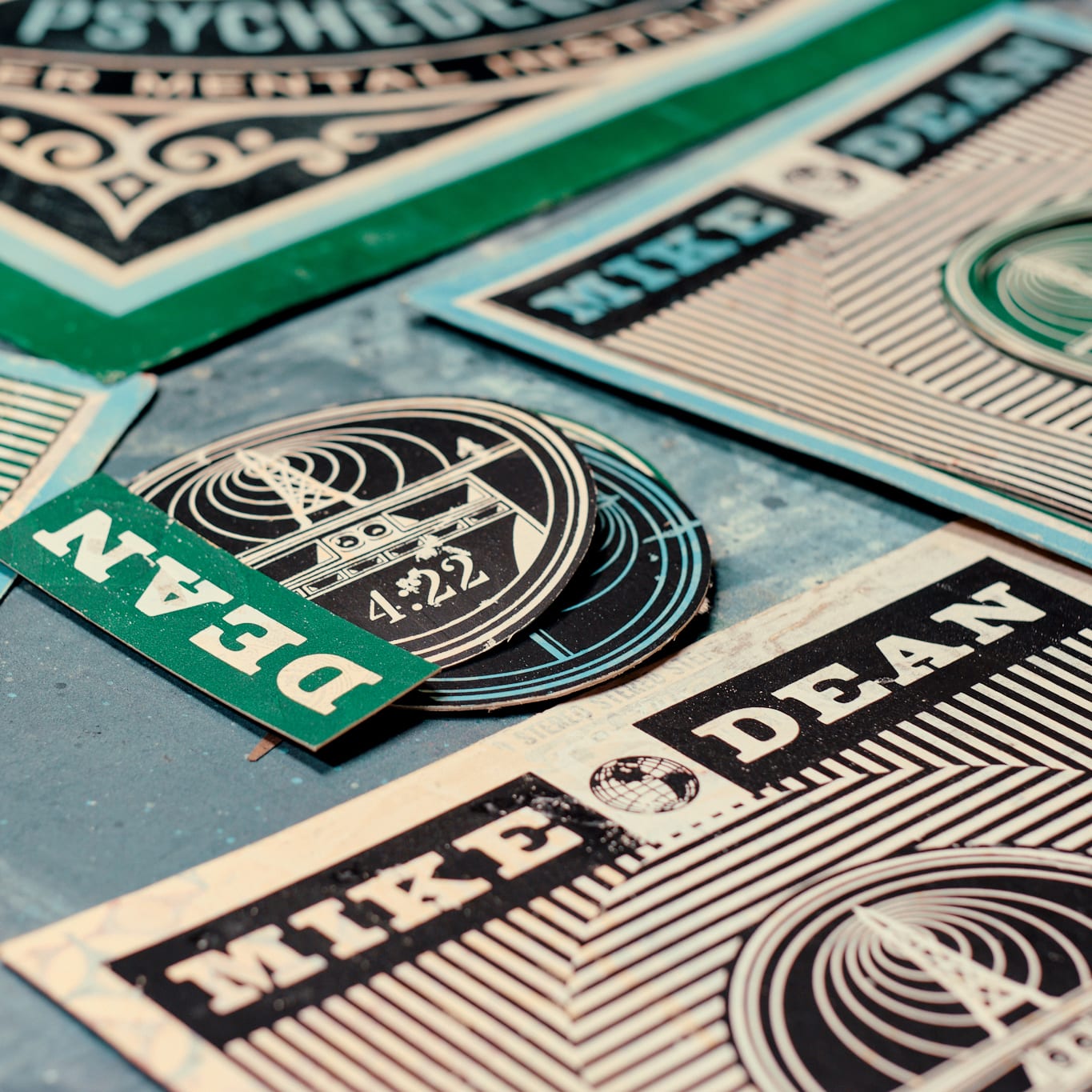
I love the other imagery that you’ve worked into the piece: the radio waves emanating out from the tower and the loudspeakers blasting. It’s this idea of something that’s ringing to the four corners of the earth.
Shepard: Yeah, exactly. And the globe rotating in the corner and all that. I mean, one of the things that makes me so moved by music is its ability to become an almost universal reference point, where each person’s experience with it is personal and different, but there’s a collectiveness to it also. And I want art to function more that way. Whenever I’m looking at arts deficiencies, I always look at what music can accomplish as a model to emulate.
What deficiencies are you thinking of, specifically?
Shepard: That art a lot of times doesn’t make people feel in the same way. And people are intimidated by art, so they don’t share their enthusiasm in the same way people share their enthusiasm for music. There’s a lot of music that can have a lot of layers to it where the most sophisticated, intelligent person is experiencing it in a way that they’re feeling in their gut and in their brain, and somebody else is just like, “Yeah, sounds good!” And yet still, that can be a unifying thing. With a lot of my art, I’m trying to examine that model and say, “What has visual appeal? And then what little things can I pepper in that might be provocative, that make people think a little bit?”
With this project, if all it does is make people from Mike’s audience look at the visuals and think about what value there is there… And then my audience is listening to Mike’s music and going, like, “Yeah. This this is bad-ass.” That’s meaningful. And I think that’s going to happen at the very least. Cross-pollination of ideas and creativity is always good.
For me, listening to Mike’s music, it’s evocative of a lot of things that have been meaningful for me, whether it was John Carpenter’s film scores… His movie They Live was where I got the idea to use obey in my work. Kraftwerk, Phillip Glass’ Koyaanisqatsi soundtrack. It’s very cinematic, what Mike’s done, as far as what it conjures for me, but everyone else will have a different interpretation. That alone takes me on a journey into the past and the future.
Do you have some personal favorite Mike Dean projects that you want to highlight while we’re all in the Zoom together, Shepard?
Shepard: Yeah. I’d say I’m a big fan of the Geto Boys and of a lot of Jay-Z’s stuff. And I like a lot of the stuff he’s done for Kanye, even though I’m not… a big fan of Kanye’s personality. Sometimes I have to wrestle with what I like sonically versus what I like personality-wise. [Laughs.]
Mike: I’m like that, too. I can’t get past the person.
Shepard: Yeah. And then the cool thing is… Once you know who Mike is, and you know some of his sounds, then you see there’s a lot of imitators out there, too. Like, you’ve influenced a lot of people, Mike. That’s fascinating. When you know my style as a visual artist, there will be something that’s like, “Ah. I know that’s not Shepard, but that’s definitely inspired.” And that’s cool.
Mike: At least there’s not a knock-off weed brand that says “Obey” yet. I’ve seen lots of different knockoffs of famous artists’ weed brands.

Mike, I wanted to ask about this “Producer Plug” series that you’ve been participating in with our friend Distrolord. What’s going on with that? It sounds like a cool way for aspiring producers show you their best stuff, and then you pick your favorites…
Mike: Classic beat battle, It’s cool. Gustavo—Distrolord—he has different hosts and judges every week. I think last week he had, what was it, Ghostface and Bob James?That’s pretty cool. Bob James is such a fuckin’ over-sampled person.
A real giant in the culture.
Shepard: You know that “Rock The Bells” LL was originally supposed to use the “Mardi Gras” sample that’s got the bells from Bob James, but then Rick Rubin gave it to Run-DMC, and so LL was like, “But I already wrote the lyrics to Rock The Bells.” So, they switched it out to the AC/DC guitar stab and then LL was like, “Fuck it—It’s just a good sounding phrase. So even if it doesn’t make sense with the instruments in the sample, ‘Rock The Bells,’ I’m just gonna own it.” And that’s kind of awesome. Oh God, what’s the Run-DMC song that uses it?
Mike: “Peter Piper.”
Shepard: That’s it! Exactly. God damn. Did you internet that or did you off the dome that?
Mike: I Googled it. [Laughs.]
Mike, we were all looking forward to 4:22. Is there anything you can share about some of the other things you have coming up? I’ve been reading that you’ve been working on the Utopia project with Travis. Is that still coming along?
Mike: Yeah, Travis, Kanye… just the regular cycle of my artists. And we’re working a lot with Iann Dior’s new music. Who else? Everything else, I can’t really talk about much.
I love the blasé way you run through that list… “Yeah. Travis, Kanye, just the usual thing.” Is there anybody that gets you slightly nervous to get in the lab with?
Mike: Probably Shepard Fairey. There was something we did the other day. I was like, “Oh, shit what am I doing?”
Shepard: [Laughing] Mike brought his synthesizers to my art studio—speakers and everything, the whole set up. And I was working on the physical art while he was doing that. I was thinking to myself, like, “This is insane that he’s improvising a song right now while I’m working on this art right there. And because it’s all being documented, I have to actually focus on the art rather than focus on him and the music.”
Because you would like to just sit and vibe with him and watch.
Shepard: Exactly. He played for about 15 minutes. And then he’s edited that piece down already. The way that Mike works so spontaneously, it’s incredible. I do not work that way as a visual artist. I’m very meticulous about building one little part at a time. There’s a lot of trial and error to get the composition together. But I’m amazed and envious of how it flows forth from Mike when he’s working. That’s the cool thing about this project. It’s a little sort of yin-yang process-wise, but I think it all comes together harmoniously in the end result.
While you were collaborating, did you have a chance to debate music, politics, Kanye’s personality. Did you guys get into any discussions of that nature?
Mike: A little bit here and there. It’s been more about the art. We’ve been under deadlines… We were happy to see the fucker [Derek Chauvion] get convicted yesterday. We talked about that.
That was something.
Shepard: I think Mike and I are on pretty much the same page politically. We both care about criminal justice, homelessness, people suffering from mental health issues. We care about the environment, all those things. And yet, art is a really great way to have some personal therapy, whether it’s addressing those things directly or indirectly. But I find that ability to sort of escape while I’m making stuff and then engage with the end product—or if not the end product itself in terms of what it’s talking about topically—at least some of the revenue can go to things I believe in. I think we both feel just lucky that we get to be creative for a living. Because there’s a lot of miserable people who have no outlet for expression, and we do.

